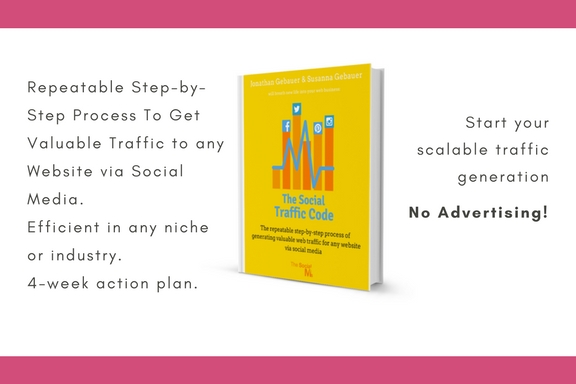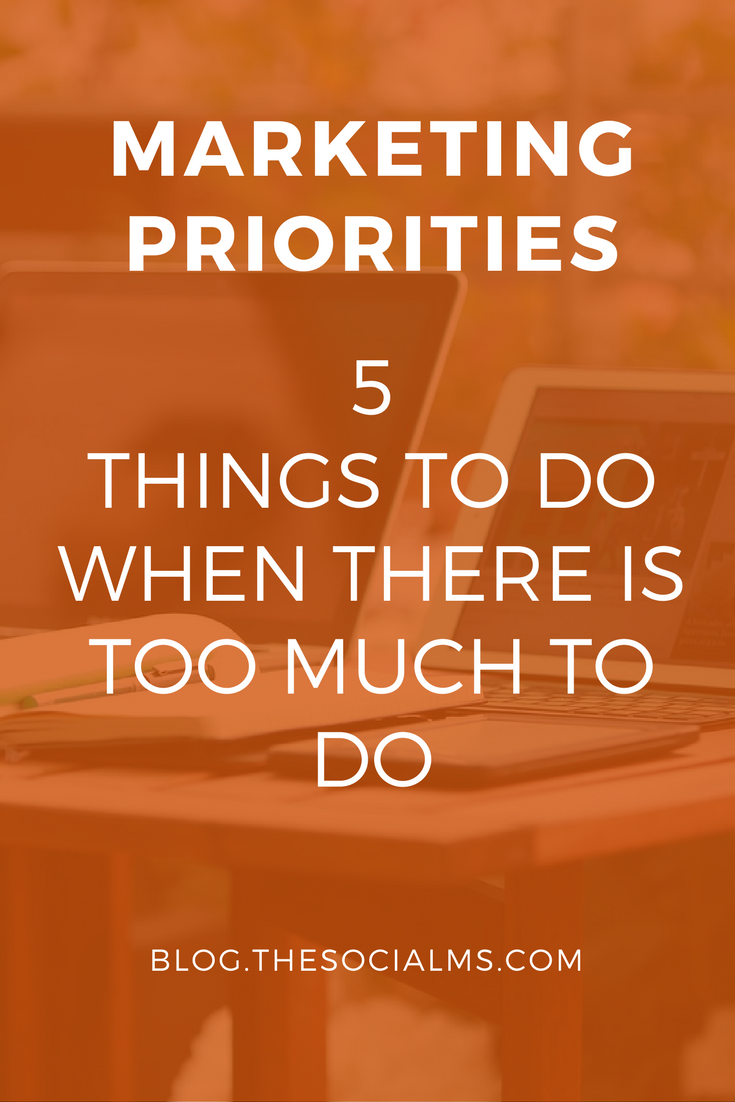When you are starting to market your company, your services or yourself on social media or elsewhere, there are many things to learn and even more things you can try. Most of them probably won’t work – but you need to try a lot to find some things that do work.
The reality is that marketing consists of many possibilities, options and opportunities. Too many to try them out at once. So many that when you are starting out you will probably be overwhelmed.
So many things you could do and that could work, that many, if not most people give up before they even start. You don’t have time for that, right?
That really is a shame. Because even if you hire an expert (like me… just to mention it once :)), this expert won’t do everything. He won’t try everything, chances are he will prioritize what to try now, what to put on hold and what will never (ever) work.
Before you read on - we have various resources that show you exactly how to use social networks to gain massive traffic and leads. For instance, check out the following:
FREE Step-by-Step Twitter Marketing GuideFREE Pinterest Marketing Ebook
Prioritizing can be learned – in fact, most of the consulting gigs I get hired for aren’t full-blown-interim-CMO-type-full-campaign-several-months type of things. I am a startup marketer and startups don’t have the money for that. Instead, they are a couple of days of analysis and coaching there, a workshop at a university there, and so on. What I often do is teach a mindset. And teaching marketing in startup environments starts with teaching how to set your priorities.
Following is a list of things to do when you have too much to do – use these to know what to do and what to put on hold.
1. Start With The Basics
I know, you are probably a startup dreaming of making it big. And you already know that the statistics are against you – you’ve been told countless times that only 10% of startups hit the home run.
This often leads to panic and ignorance – and quite understandably so. If your chances are slim, you need to go in full force and come up with a growth hack that will make you grow virally, right?
Wrong.
No startup ever got to a successful marketing strategy without getting their marketing basics right. Want an example? Think of Facebook – the worlds biggest social network. They started marketing themselves locally – as a Harvard-exclusive replacement of the standard university Facebook. When they worked out how to do that (got their basics right!) they scaled that up to more universities – and the rest is history.
If you are going in full force for social media marketing strategies, that means you cannot start with going viral by posting a cat picture five minutes after you set up your account (I know, that is kind of a cheesy example…). It means you need to carefully select your networks, set up your accounts and start posting. You need to learn to grow your audience and then enforce your growth.
Marketing always starts with learning to get the basics right.
Hey, before you read on - we have in various FREE in-depth guides on similar topics that you can download. For this post, check out:
FREE workbook: CREATE AWESOME BLOG POSTSFREE Beginner's Guide: START A BLOG
2. Check If What You Would Like To Do Makes Sense In Your Current Situation
 I had a client in the recent past who wanted to do more testing. Meetings often consisted of answering hundreds of questions like:
I had a client in the recent past who wanted to do more testing. Meetings often consisted of answering hundreds of questions like:
- “Why aren’t we doing more A-B testing?”
- “Shouldn’t we segment our email lists more?”
- “Shouldn’t we brainstorm something that can go viral?”
And many more of those. (Sad story really…)
In certain if not many situations these questions make absolute sense – but the fact was, not in their situation!
A-B testing landing pages and messages when your site has 20 – 100 clicks per day simply takes too long, especially when you don’t have time. You would need at least a week per test. Test messages on Twitter and test them repeatedly – save the time and money you need for developing several landing pages.
Segmenting an email list of 200 addresses doesn’t make any sense at all. You need to factor in that only 10 – 40 percent of the subscribers will actually open the email. If you are lucky, 40 people will open your email – and that is far too few to run statistically relevant tests.
Running something that will go viral is highly improbable in any situation. If you are small the benefits are small as well: 99% of the time it is not your service that goes viral, but something you posted. You will get a lot of traffic for a couple of days and then it will drop back to normal. Worst case scenario: Your service will go down or you will have to pay for additional capacity with no actual benefit.
So always ask the question if what you would like to do and what you would like to achieve with it actually makes sense!
3. Learn To Ask The Right Questions
This is somehow related to the last one. Successful marketing strategies often originate with someone who asked the right questions – which means that these questions are vital to getting info about which marketing priorities are the right priorities for you. Here are a few examples:
- “Is the benefit visible?”
- “Why should a visitor sign up?”
- “What does my target audience want?”
- “Do I reach my target audience?”
- “Does my message motivate my target audience to take the next step?”
- …
Whether the question is the right question depends highly on your current situation – it doesn’t make sense to ask whether a newsletter subscriber would buy your product when you are not sure how to get newsletter subscribers.
4. Prioritize By Potential Effect, Probability Of Success And Effort You Need To Put Into It
This kind of leads back to the introduction: There are so many things to try out and so little time. So you need to classify your options and opportunities. This is vital to getting your marketing priorities straight!
That is why you need to take an approach that is slightly more analytical in nature as you cannot try everything out just by chance.
The three factors that you need to apply to every option are:
- The potential effect that the option can have on your marketing if successful: Virality is, of course, a very high potential, but this would be countered by its very low probability.
- The probability of success of the option: Yes, factor in how likely it is that the measure will be successful in comparison to other opportunities.
- How much effort you will need to put in. You could also call this factor your investment – as it includes the budget and the time you need to put in.
In my experience, these three factors come naturally to most people – but you can also come up with a complex mathematical formula to apply to a long list of options. Maybe I should write a longer article just about this aspect – but for now, the above will do.
The point is that you are after measures that have the biggest probability of success while coming in cheap and being highly effective (if successful of course). Being able to rate them in this way depends highly on being able to have a good understanding on your current situation and being able to ask the right questions.
5. If You Are Unsure – Start Testing
If you are not satisfied with your marketing priorities you can always get more information. You can run what marketers and startuppers call tests.
Testing doesn’t always mean that you need to run complex tests with loads of data to acquire, testing just means getting intelligence data in any way possible. Often, the most effective way of testing is simply to ask your audience some questions.
There are the tools that open lightboxes on your webpage asking a random visitor some questions – for instance if he understood the information on your web page or if he is interested in learning more about the team, whether he would like an individual call, etc…
Often you can also simply ask some people for help on Twitter – remember, your goal is to get information quick and apply it fast.
Final Words
Getting your marketing priorities straight and prioritizing your tasks is very important – and often either done wrong or not at all. The above is just a quick overview of what can be done and what I think should be done. What are you doing to get your marketing priorities right? Feel free to post your additions to the comments section!
When marketing and social media gets overwhelming you need to focus on one or two things that work. Don’t try everything at once, start with a proven process that has worked in the past and will work for you, too. You can easily see results within days if you follow the step-by-step action plan!
Do you want to know what you have to do to get traffic and leads from social media? Our ebook “The Social Traffic Code” is for you!
If you liked this article, would you do us a favor? Please pin it! Here is an image you can use:



